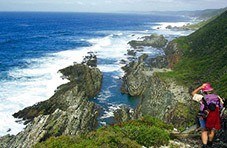The World-wide known Otter Trail dates back to 1968, which makes it the oldest official South African hiking trail. It is also one of the most popular ones among many this beautiful country has to offer. The Trail was named after the African clawless otter, a powerful swimmer which happens to be found in this area. Lasting 5 days and 4 nights, the Otter Trail does require a bit of strength and stamina, but the beauties you'll get to experience while hiking make the challenge well worth taking on.
While on the way, camps such as Ngubu, Scott, Oakhurst and André will provide overnight accommodation and a chance to recharge.
Diverse Natural Wonders of the Otter Trail
Starting at the Storms River Mouth Rest Camp, the Trail stretches just over 40 kilometres westwards, winding through the Tsitsikamma forest. Constantly changing scenery leads you through indigenous forests and past caves, astonishing rock formations, ravines and beaches. As the Otter Trail twists close to the coastline, you'll have the Indian Ocean constantly in view. A number of rivers and streams along the way form cascading waterfalls as the result of a high tide, and quite a few freshwater pools serve as a source of well-deserved refreshment.
Many of the species of the Cape Floral Kingdom can be seen while hiking, along with ferns and fungi growing on decaying trees, as well as a variety of animals which have made their home next to numerous indigenous plants. Rich and varied fauna includes African Black Oystercatcher (actually feeding on mussels and worms, and not oysters), Knysna Dwarf Chameleon (slow lizard which is a master of camouflage), and, naturally, the Cape Clawless Otter.
Five Days of Jaw-Dropping Beauty
The hike starts from the Garden Route National Park with a relatively easy 5 km walk, even if you might have to do some boulder hopping. On the way, you'll get to explore large Guano cave and admire a majestic waterfall immediately after. The most varied part of the Trail follows on day 2, beginning with a steep climb and taking you on a forest walk to Skilderkrans, which is where one gets the opportunity to spot dolphins and whales.
The third day starts with a river crossing and leads you through fynbos along the rocky coastline. Having reached Elandsbos river, you might be tempted to shed off your clothes and go for a swim. The longest section of the Trail on day four includes a walk through Bloukrans estuary, and besides the varied and beautiful flora which you'll be exposed to on this section, you might also spot the Cape Clawless Otter, Caracal, Bushbuck, Genet, Leopard, Vervet Monkey or a Baboon. During the final day of the hike, you'll get to enjoy an easy stroll to Nature's Valley, which is where the Trail ends by a steep decent and a walk across the sandy beach.
Combining the best of the coast and the forest, this area of incredibly diverse natural beauty has the potential to provide a life-changing experience.




